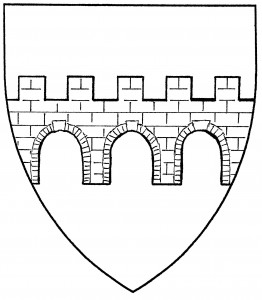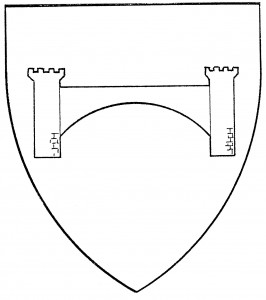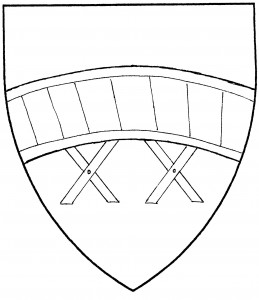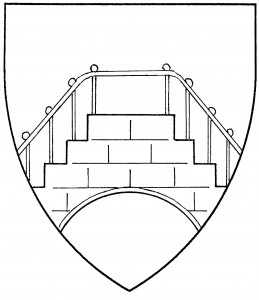A bridge is an edifice, built to carry traffic over a river, gorge, or the like. The most common depiction in medieval armory showed a stonework bridge, drawn throughout, with three or more arches or spans; it was usually drawn with water flowing beneath it as well. The illustration is taken from the canting arms of Trowbridge, mid-16th C. [Bedingfeld 58].
In Society armory, the default bridge is not throughout, but terminates with a tower at either end (and frequently with towers between arches); moreover, the number of arches must be explicitly blazoned. A common Society form has but a single arch, as in the illustration; this depiction is considered negligibly different from a castle. Difference is granted between a castle and a bridge drawn in the period style (i.e., throughout, with multiple arches).
Period armory also has some examples of smaller bridges, intended to be footbridges: e.g., the wooden boardwalk, drawn throughout and supported by scaffolding, in the canting arms (German Steg) of Steger zu Ladendorff, 1605 [Siebmacher 39]; or the stepped stone footbridge, complete with handrails, in the canting arms (Italian ponte) of Ponte, c.1550 [BSB Cod.Icon 273:165].
See also drawbridge, wall.
The Baron of the Bridge bears: Azure, a twin-towered three-arched bridge and on a chief Or a laurel wreath vert.
Grímr Víthfari bears: Or, atop a bridge of three arches throughout a tower, the streams transfluent gules.
Jessa of Avondale bears: Argent, three pallets wavy azure, overall a bridge of two spans throughout sable masoned argent.
Sarah Minet bears: Azure, a footbridge Or.



